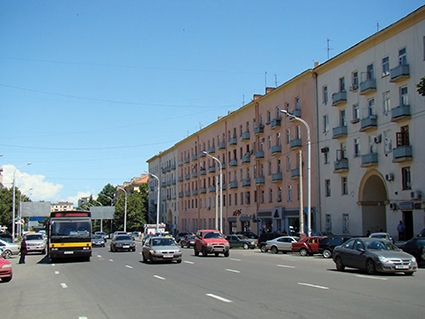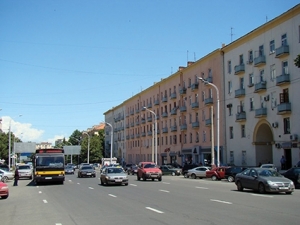Tbilisi City Hall Moves to Initiate ‘Khrushchovka’ Replacement Project
During a government meeting late last week, Tbilisi Mayor Kakha Kaladze renewed discussions on the project to give the city’s architectural façade a face lift. In July, City Hall completed the Tbilisi Land Use Master Plan. The plan includes the realization of one of Kaladze’s campaign promises – to replace the city’s khrushchovka apartment blocks.
Khrushchovka is a term used for a type of Soviet-built apartment building, typically a low-cost, concrete-paneled (or sometimes brick), generally five-story building, constructed during the government of Soviet Premier Nikita Khrushchov in the mid-1950s and early 1960s.
During his election campaign, now-Mayor of Tbilisi, Kakha Kaladze, promised to gradually tear down and replace the approximately 700 khrushchovka buildings throughout the city, calling them “ugly and dangerous to live in.” The buildings, found all across the former Soviet Union, were originally built with a 25-year life span in mind, but most are now approaching 60 years of use. They were built quickly and simply, designed to be functional, cheap, and to fit in as many families as possible as a response to the post-WWII housing crisis faced by the Soviet Union as waves of migration brought more people to urban areas. In fact, khrushchovkas were praised at the time as an innovative solution to a severe problem. In 1967, an official from the US’ National Bureau of Standards was quoted in the Chicago Tribune as saying, “What the Russians have done is to develop the only technology in the world to produce acceptable, low-cost housing on a large scale.”
Last week, Kaladze said that “interest” had been “expressed on the development of a new district on three hectares of municipal property in Varketili. This is a project under which the replacement of khrushchovkas in Varketili should be carried out.”
The debate over khrushovka apartments is well known in Georgia – they have clear disadvantages, but also several selling points. People are turned off by their non-modernity. The lack of open floor plans, low ceilings, and small kitchens and bathrooms conjure distinctly Soviet memories. Poor insulation, uneven floors, cracked walls, dilapidated stairwells, and no elevators pose more practical concerns. Often, repairs to the building have been done in a semi-professional patchwork over time, causing safety concerns. For those who don’t live in a khrushchovka, they are impossible to miss. The discolored grey concrete and graffiti covered walls of most buildings are an eyesore, particularly compared to Tbilisi’s elegant and delicate pre-Soviet architecture or even some of the more recent sleek glass or colorful plastic creations.
Many, however, sing the praises of khrushchovka living. The buildings provide a quality of family life that is hard to beat with their large, community-focused courtyards, mature trees, and wide walkways between buildings. Many owners have invested significant time and money renovating their apartments and are resistant to the idea of being resettled. Generations of a family have often lived in the same apartment, embedded with memories and history, relationships with neighbors, and affection for the neighborhood.
There are also concerns over new developments, built sloppily by developers in an attempt to make a quick profit, many older buildings are regarded as more desirable than new constructions in terms of building quality.
The plan is to construct 75,000 m2 of apartments in the three-hectare space in Tbilisi’s Varketili neighborhood. City Hall in now soliciting proposals from construction companies to take on the project. At the end of May last year, Kaladze spoke to the press about his plan for the massive replacement project, saying that “The first stage of replacements is planned for four blocks of khrushchovka apartments in the 6th and 8th quarters of the III Massive in the Varketili District” – in the east of the city, near the airport. Currently, 170 families live in these buildings, and Kaladze vowed they would be given new “modern and European style” apartments, the same size as or larger than their current homes. “This is not a one-time project,” said Kaladze, “the process is ongoing and it will give us the chance to implement the large-scale so-called khrushchovka project and I am very glad that this project has started.” During his election campaign, Kaladze assured voters that that displaced khrushchovka owners would be able to choose between financial compensation or a new apartment.
An article published last week by Caucasus Business Week (CBW) shared data from Gvantsa Gujelashvili, the owner of myclient.ge, an online Georgian real estate agency. Gujelashvili estimates that there are currently more than 500 khrushchovka buildings in the city, mostly in the neighborhoods of Dighomi, Varketili and Saburtalo – particularly near Vazha-Pshavela Ave.
“There is no demand for these types of flats,” CBW quotes Gujelashvili, “The level of people’s demand has already changed and they prefer to purchase [an apartment in a] building with better infrastructure instead of [in an old building, with] old sewage and communication systems.”
Myclient.ge says the average price per square meter for a khrushchovka apartment is generally a fraction of the price of other types of construction. For one khrushchovka square meter in Saburtalo and Didube, apartments are priced in the mid- $600s, while in Varketili, Temka, Samgori and Gldanula, a square meter goes for $450-475, on average.
By Samantha Guthrie
Image source: allnews.ge












